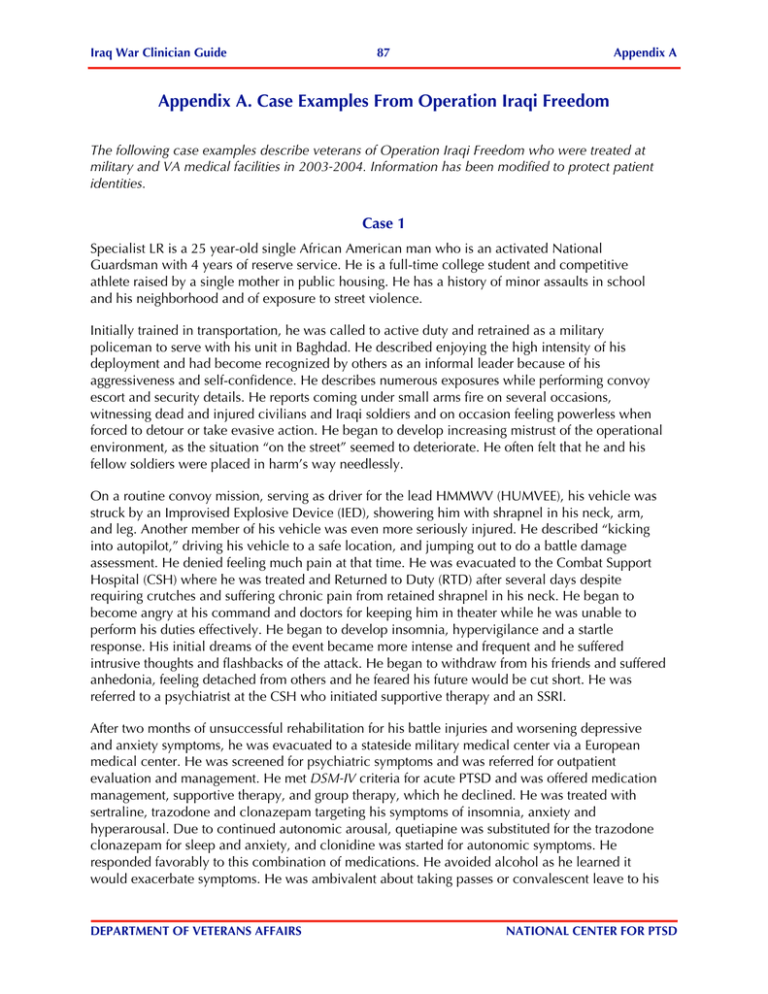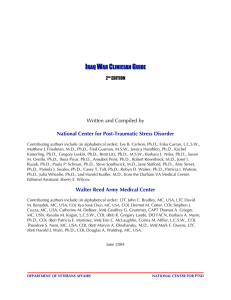Appendix A. Case Examples From Operation Iraqi Freedom
advertisement

Iraq War Clinician Guide 87 Appendix A Appendix A. Case Examples From Operation Iraqi Freedom The following case examples describe veterans of Operation Iraqi Freedom who were treated at military and VA medical facilities in 2003-2004. Information has been modified to protect patient identities. Case 1 Specialist LR is a 25 year-old single African American man who is an activated National Guardsman with 4 years of reserve service. He is a full-time college student and competitive athlete raised by a single mother in public housing. He has a history of minor assaults in school and his neighborhood and of exposure to street violence. Initially trained in transportation, he was called to active duty and retrained as a military policeman to serve with his unit in Baghdad. He described enjoying the high intensity of his deployment and had become recognized by others as an informal leader because of his aggressiveness and self-confidence. He describes numerous exposures while performing convoy escort and security details. He reports coming under small arms fire on several occasions, witnessing dead and injured civilians and Iraqi soldiers and on occasion feeling powerless when forced to detour or take evasive action. He began to develop increasing mistrust of the operational environment, as the situation “on the street” seemed to deteriorate. He often felt that he and his fellow soldiers were placed in harm’s way needlessly. On a routine convoy mission, serving as driver for the lead HMMWV (HUMVEE), his vehicle was struck by an Improvised Explosive Device (IED), showering him with shrapnel in his neck, arm, and leg. Another member of his vehicle was even more seriously injured. He described “kicking into autopilot,” driving his vehicle to a safe location, and jumping out to do a battle damage assessment. He denied feeling much pain at that time. He was evacuated to the Combat Support Hospital (CSH) where he was treated and Returned to Duty (RTD) after several days despite requiring crutches and suffering chronic pain from retained shrapnel in his neck. He began to become angry at his command and doctors for keeping him in theater while he was unable to perform his duties effectively. He began to develop insomnia, hypervigilance and a startle response. His initial dreams of the event became more intense and frequent and he suffered intrusive thoughts and flashbacks of the attack. He began to withdraw from his friends and suffered anhedonia, feeling detached from others and he feared his future would be cut short. He was referred to a psychiatrist at the CSH who initiated supportive therapy and an SSRI. After two months of unsuccessful rehabilitation for his battle injuries and worsening depressive and anxiety symptoms, he was evacuated to a stateside military medical center via a European medical center. He was screened for psychiatric symptoms and was referred for outpatient evaluation and management. He met DSM-IV criteria for acute PTSD and was offered medication management, supportive therapy, and group therapy, which he declined. He was treated with sertraline, trazodone and clonazepam targeting his symptoms of insomnia, anxiety and hyperarousal. Due to continued autonomic arousal, quetiapine was substituted for the trazodone clonazepam for sleep and anxiety, and clonidine was started for autonomic symptoms. He responded favorably to this combination of medications. He avoided alcohol as he learned it would exacerbate symptoms. He was ambivalent about taking passes or convalescent leave to his DEPARTMENT OF VETERANS AFFAIRS NATIONAL CENTER FOR PTSD Iraq War Clinician Guide 88 Appendix A home because of fears of being “different, irritated, or aggressive” around his family and girlfriend. After three months at the military medical center, he was sent to his demobilization site to await deactivation to his National Guard unit. He was referred to his local VA Hospital to receive follow-up care. Case 2 PV2 RJ is a 26-year old white female with less than 12 months of active duty service who was deployed to Iraq in September 2003. She reported excelling in high school but moved out of her house after becoming pregnant during her senior year. After graduating from high school on schedule, she worked at several jobs until she was able to become an x-ray assistant. She had been on her first duty assignment as an x-ray technician in Germany. As a single parent she attempted to make plans for her dependent 5-year old son. However, when notified of her impending deployment she needed to make hurried and unexpected care plans for her son. Within a week of being deployed to Iraq the service member began experiencing depressed mood, decreased interest in activities, increased appetite, irritability, increased social isolation with passive suicidal ideations, and insomnia due to nightmares of the devil coming after her. She also began believing Saddam Hussein was the “Antichrist.” In addition, she began experiencing command directed auditory hallucination of the devil whispering to her that people in her unit were saying she was stupid and that she should make them shut up. At one time, the devil told her to throw things at them. Her guilt intensified as her wish to act on the voices increased. She also described seeing visual hallucinations of “monsters” that were making fun of her. These symptoms intensified when she went from an in-processing point to her assignment in Iraq. They also worsened when she ruminated about the stresses of being in Iraq (bombs exploding, missing her son and family, disgust at other women who were seeking the attention of men). Of most concern, she was worried that she might not survive the deployment. When she was around people, she experienced palpitations, increase swearing, shaking, shortness of breath, abdominal cramping, and dizziness. In hopes of getting rid of her symptoms especially the voices and monsters, she ingested Tylenol #3s she had obtained for a minor medical procedure. After confiding her symptoms to a military friend, RJ was referred for an evaluation and was evacuated out of Iraq to CONUS via Germany. When she returned to CONUS, RJ also shared with the treatment team that in the week prior to deployment she believed she was drugged by a date and that he sexually assaulted her. RJ was hesitant to discuss the few memories she had of the incident, due to embarrassment. She denied any other previous traumatic events but she stated she distrusted men in general, as many men in her life had been unreliable or irresponsible. She admitted to occasional alcohol use but denied any drug use. Throughout the hospitalization, her greatest concern was being reunited with her son and leaving the military. She was treated with a combination of antidepressant and antipsychotic medications that resulted in improvement in her symptoms. Despite improvement, RJ underwent a Medical Evaluation Board for diagnoses of Major Depression with Psychotic Features and PTSD. DEPARTMENT OF VETERANS AFFAIRS NATIONAL CENTER FOR PTSD Iraq War Clinician Guide 89 Appendix A Case 3 SFC W is a 45-year-old divorced Operation Iraqi Freedom Reservist who was involved in a motor vehicle accident in Afghanistan in Jun 2003. SFC W suffered a Lumbar Burst Fracture and had multiple surgical procedures with instrumentation and fusion at a European military medical center, which was complicated by a Deep Vein Thrombosis. SFC W was transferred through the Aeromedical Evacuation System to a stateside medical center where he was admitted as a Non-Battle Injury for Inpatient Rehabilitation for Spinal Chord Injury. SFC W’s Treatment Plan consisted of a Rehabilitation Program involving Physical and Occupational Therapy with goals of independent ambulation with an assistive device and to establish a bowel and bladder program. The Coumadin Clinic treated his Deep Vein Thrombosis and he was evaluated by the Traumatic Brain Injury Program staff. Pain was controlled with MS Contin 15 mgm two times a day with Oxycodone IR 5 mgm 1-2 tabs every 4-6 hours as needed for breakthrough pain and Ambien 10 mgm per day as needed for sleep problems. Other staff included in his care included Nursing, Social Work, Chaplain, Reserve Liason, and Medical Holding Company, and Medical Board staff. SFC W was followed by the Preventive Medicine Psychiatry Service (PMPS) in accordance with the service’s Operation Iraqi Freedom Protocol. PMPS staff initially recommended beginning therapy with an SSRI such as Sertraline at a starting dose of 25 mgm a day to address concerning symptoms, such as his increased startle response, emotional lability, and intrusive thoughts, which the staff thought could be prodromal for an Acute Stress Disorder. PMPS staff also incorporated a combination of hypnotic and relaxation techniques to assist SFC W with sleep and pain related problems. Staff recommended increasing sertraline to 50 mgm per day because he reported that he was continuing to be troubled by some memories of his accident. Aside from the target symptoms that were addressed above, no other psychiatric issues were identified. An initial Post Deployment Health Assessment Tool (PDHAT) was completed during SFC W’s hospital admission. He endorsed depressive symptoms at a level of 11 (a score of 10 or above indicates a potential concern) and endorsed symptoms consistent with PTSD (one intrusive symptom, two arousal symptoms and three avoidance symptoms) at the level of a little bit. In June 2003, SFC W was transferred to the Spinal Chord Rehabilitation Program at a VA Hospital. He was able to ambulate with the assistance of a walker, pain in his back and left leg was controlled with pain medicine, and his problems with a neurogenic bowel and bladder were well controlled with a daily bowel and bladder program. Additional Traumatic Brain Testing and Coumadin regulation was requested. Soldiers are contacted either telephonically or at the time of a follow-up visit to WRAMC and are assessed for PTSD, Depression, Alcohol Usage, Somatic Complaints, Days of Poor Physical and/or Mental Health and Lost Productivity, and Satisfaction with Health Care. SFC W could not be reached by phone until the 6-month PDHAT follow-up. At that time he met criteria for Major Depression and had symptoms consistent with criteria for PTSD at the moderate level. He reported that he had lost 20 days of productivity due to physical and mental health problems. In addition, he reported problems with pain, sleep, sexual functioning, and the fact that he will never be the same again. He is able to ambulate with the assistance of a walker within his home and uses a wheel chair for outside excursions. He continues with a bowel program. His DEPARTMENT OF VETERANS AFFAIRS NATIONAL CENTER FOR PTSD Iraq War Clinician Guide 90 Appendix A need to self-catheterize limits his visits outside the home. He is clinically followed at a local VA by Psychiatry, Neurology, Spinal Chord Program, and Physical Therapy. He reported taking between 25-35 pills a day, including Trazadone for sleep and sertraline 100 mgm po BID for treatment of Depression and PTSD. He has accepted his functional limitations and is trying to adapt to the changes in his lifestyle. His support system is fairly good, he has a very supportive wife, his Reserve Unit is in contact with him, and he has attended social functions in recognition of returning Reservists. A request for case management services was submitted to the VA Hospital to assist SFC W in understanding his medications, adapting to his functional limitations and understanding his long term prognosis because of his spinal chord injury, and working through his PTSD symptoms to include trauma bereavement. Legal Assistance at WRAMC also assisted him with a claim for personal property lost as a result of his deployment to Iraq. Prior to his deployment to Iraq, SFC W worked as a truck driver for a transportation company, a job that he will not be able to return to. His Medical Board is being processed and he will then be eligible for both Army Medical Retirement and Veterans benefits. Case 4 SGT P is a 24-year-old married AD USA E5 who sustained penetrating wounds to his Left Arm, Left Ribs, and Left Leg in an Improvised Explosive Devise attack while in Iraq. Initially his wounds were treated in Kuwait and he was MEDEVAC to a European military medical center where he underwent surgery to repair a fractured left ulna bone in the summer 2003. SGT P was Air Evacuated and admitted to the General Surgery Service at a state side medical center. His recovery was uncomplicated and consisted of mostly rehabilitation and wound care. He was initially followed by General Surgery, Vascular Surgery, and Orthopedics and was then discharged to Inpatient Physical Medicine and Rehabilitation (PMR) Service. While on the PMR Service, he progressed to ambulating hospital distances using a lofstrand crutch and was moderately independent with Activity of Daily Living. His pain was well controlled and he was discharged on Percocet 1-2 tabs every 4-6 hours, Motrin Tabs 600 mgm 3x per day as needed, and Ambien 10 mgm every night for sleep. SGT P was followed by the Preventive Medical Psychiatry Service in accordance with PMPS’s Operation Iraqi Freedom Protocol. The PMPS staff initially met with him and offered support to set the milieu to establish a therapeutic alliance with him. His initial request was for assistance with contacting his Command as he had not communicated with them since his injury and felt cut-off from his Unit. During his first week in the hospital, Ambien 10 mgm po at bedtime was ordered to assist with sleep problems. He subsequently reported that Ambien was only minimally helping with his sleep problems and he was now experiencing nighttime “sweats.” He denied experiencing any other arousal or intrusive symptoms and only endorsed limited avoidance of television news on OIF activities. PMPS staff discussed possible risks and benefits of starting Propranol 20 mgm nightly to limit sympathetic discharge activity. SGT P agreed and was started on Propranol 20 mgm at bedtime. Follow-up reports indicated that he was sleeping well and his autonomic hyperactivity had decreased. The use of pharmacotherapy interventions decreased his sleep disturbances and to be more open and responsive to psychotherapeutic interventions. PMPS staff also incorporated a combination of hypnotic and relaxation techniques to assist him with sleep and pain related problems. Cognitive Behavioral Therapy helped him understand how his traumatic experience may have altered his thoughts and interpretations of events and what effect DEPARTMENT OF VETERANS AFFAIRS NATIONAL CENTER FOR PTSD Iraq War Clinician Guide 91 Appendix A the altered perceptions had on his emotions and behaviors. PMPS staff also assisted him in working through feelings of anger and reinforcing his coping strategies, identifying his strengths and assets. The initial Post-Deployment Health Assessment Tool was completed during SGT P’s inpatient admission, approximately 16 days after his injury. At that time, he endorsed criteria for Major Depression and endorsed symptoms consistent with PTSD at the moderate level. Two months after admission, SGT P was discharged from the hospital and placed on convalescent leave. He had follow-up appointments in the Orthopedic and Vascular Clinics, Physical Therapy, and Preventive Medical Psychiatry. He stayed at base hotel for the duration of his outpatient therapy. PMPS staff followed SGT P on a regular basis during the course of the hospitalization and outpatient treatment, with visits ranging from 1-3 times per month. A combination of psychotherapy, hypnotherapy, and CBT interventions was provided. Ambien and propranol were not needed after the initial discharge medications were issued. He was able to regain control over the intrusive and arousal symptoms that he had been experiencing as a result of his deployment experience. Psychotherapeutic interventions assisted him in understanding the effect that his thoughts were having on his emotions and behavior and resulted in a substantial decrease in his endorsement of depressive symptoms (from 16 to 3 on the Pfizer, Prime MD Scale). Soldiers are contacted either by telephone or in person at the time of follow-up and are assessed for PTSD, Depression, Alcohol Usage, Somatic Complaints, Days of Poor Physical and/or Mental Health, Lost Productivity, and Satisfaction with Health Care. At the 3-month PDHAT follow-up visit, SGT P endorsed a depressed mood but did not meet the full criteria for depression. He endorsed depressive symptoms at a level 12 (a score of 10 or above is of concern). PTSD symptoms were endorsed at a moderate level. Although, he reported 9 days of poor mental and physical health during the previous month, he only reported 2 days of lost productivity due to poor mental or physical health. He reported excellent satisfaction with his health care. At the 6-month PDHAT follow-up visit, he endorsed depressive symptoms at a level 3 and did not meet the criteria for depression. He endorsed mild intrusive symptoms but did not meet criteria for PTSD. SGT P has returned to a light duty status while he continues to recover from his injuries. DEPARTMENT OF VETERANS AFFAIRS NATIONAL CENTER FOR PTSD




